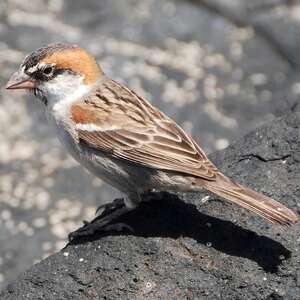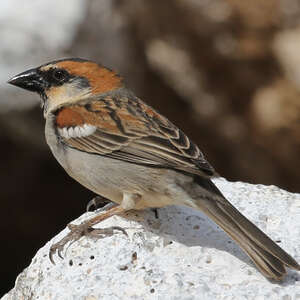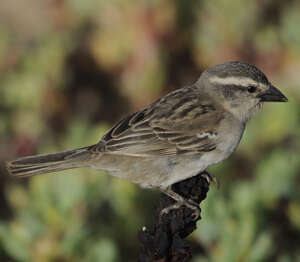Iago Sparrow
Passer iagoensis - Moineau à dos roux Moineau du Cap-Vert
Identification
Immediately recognisable as a sparrow, both sexes are more colourful than the House Sparrow; smaller than this. In the male, the most striking character is the wide orange-red eyebrow which extends to the mantle of the same colour. The cap is dark grey and the rump is rufous. The female is very similar to that of the house or Spanish sparrow with which the Iago sparrow coexists in Cape Verde. It differs by having a cream (and not ashy) eyebrow rimmed in black, giving it a more contrasted look than its congeners. As in the male, the rump is rufous, easily observed in flight.
Subspecific information monotypic species
Foreign names
- Moineau à dos roux,
- Gorrión de Cabo Verde,
- pardal-de-cabo-verde,
- Kapverdensperling,
- zöld-foki veréb,
- Kaapverdische Mus,
- Passero di Capo Verde,
- kapverdesparv,
- Kappverdespurv,
- vrabec čiernočelý,
- vrabec kapverdský,
- Kap Verde-spurv,
- kapverdenvarpunen,
- pardal de Cap Verd,
- Roðaspör,
- wróbel rudogrzbiety,
- Kaboverdes zvirbulis,
- zelenortski vrabec,
- Капверденский воробей,
- ケープベルデセアカスズメ,
- 棕背麻雀,
- kapverdesparv,
- 棕背麻雀,
Voice song and call
Habitat
Behaviour character trait
The Iago Sparrow is quite fearless. Like the domestic House Sparrow, it has grown accustomed to humans and often visits the terraces of bars and restaurants. The species is considered sedentary, but at least a portion of the young ones disperse after the breeding season.
Dietfeeding habits
Reproduction nesting
The Iago Sparrow reproduces during the rainy season, from September to March. Its nest is a ball of dry vegetation placed in a cavity, originally found in cliffs or hollow trees. We have also seen it built in lamp posts or behind wooden panels, sometimes even in open air tucked away in tree foliage or even in bushes. Colonies form loosely. The eggs are usually 3 to 5 in numbers, yet there are no known data regarding the species' incubation. Both parents take part in raising the young.
Geographic range
Threats - protection
Sources of information
- IOC World Bird List (v15.1), Gill, F and D Donsker (Eds). 2025-12-07.
- An Atlas of the Birds of the Western Palearctic, Colin Harrison
- Birds of the Atlantic Islands, Clarke Tony
- Birds of Western Africa, Nick Borrow and Ron Demey
- Handbook of the Birds of the World Vol 16, Josep del Hoyo, Andrew Elliott, David Christie
- xeno-canto, Sharing bird sounds from around the world,
- African Bird Club,
- HBW Alive,
- Birds of the Western Paleartic interactive, Cramp Simmons
- Field Guide tothe Birds of Macaronesia., Eduardo Garcia-del-Rey
Other sources of interest
 Specification sheet created on
30/07/2023 by Georges Olioso
Specification sheet created on
30/07/2023 by Georges OliosoTranslation by AI Oiseaux.net
© 1996-2026 Oiseaux.net
- Accipitriformes
- Aegotheliformes
- Anseriformes
- Apodiformes
- Apterygiformes
- Bucerotiformes
- Caprimulgiformes
- Cariamiformes
- Casuariiformes
- Charadriiformes
- Ciconiiformes
- Coliiformes
- Columbiformes
- Coraciiformes
- Cuculiformes
- Eurypygiformes
- Falconiformes
- Galliformes
- Gaviiformes
- Gruiformes
- Leptosomiformes
- Mesitornithiformes
- Musophagiformes
- Nyctibiiformes
- Opisthocomiformes
- Otidiformes
- Passeriformes
- Pelecaniformes
- Phaethontiformes
- Phoenicopteriformes
- Piciformes
- Podargiformes
- Podicipediformes
- Procellariiformes
- Psittaciformes
- Pterocliformes
- Rheiformes
- Sphenisciformes
- Steatornithiformes
- Strigiformes
- Struthioniformes
- Suliformes
- Tinamiformes
- Trogoniformes


























